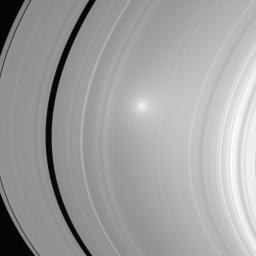
|
Opposition Surge on the A Ring
- Click the image above for a larger view
- Full-Res JPEG (1008 x 1008) (85.5 kB)
- Full-Res TIFF (1008 x 1008) (1.0 MB)
Caption:
Two images of Saturn's A and B ring showcase the opposition effect, a brightness surge that is visible on Saturn's rings when the Sun is directly behind the spacecraft.
This view is of the A ring. See PIA08248 for the view of the B ring.
The opposition effect exists because of two contributing factors. One is due to the fact that the shadows of ring particles directly opposite the Sun from Cassini -- the region of opposition -- fall completely behind the particles as seen from the spacecraft. These shadows are thus not visible to the spacecraft: all ring particle surfaces visible to the spacecraft in these two images are in sunlight and therefore bright. Much farther away from the region of opposition, the ring particle shadows become more visible and the scene becomes less bright. The brightness falls off in a circular fashion around the opposition point. The main factor to the opposition surge in this image is an optical phenomenon called "coherent backscatter." Here, the electromagnetic signal from the rays of scattered sunlight making its way back to the spacecraft is enhanced near the region of opposition because, instead of canceling, the electric and magnetic fields comprising the scattered radiation fluctuate in unison.
The images were taken in visible light with the Cassini spacecraft wide-angle camera on July 23, 2006 at a distance of approximately 262,000 kilometers (163,000 miles) from Saturn. Image scale in the radial, or outward from Saturn, direction is 13 kilometers (8 miles) per pixel.
Background Info:
The Cassini-Huygens mission is a cooperative project of NASA, the European Space Agency and the Italian Space Agency. The Jet Propulsion Laboratory, a division of the California Institute of Technology in Pasadena, manages the mission for NASA's Science Mission Directorate, Washington, D.C. The Cassini orbiter and its two onboard cameras were designed, developed and assembled at JPL. The imaging operations center is based at the Space Science Institute in Boulder, Colo.
For more information about the Cassini-Huygens mission visit http://saturn.jpl.nasa.gov/home/index.cfm . The Cassini imaging team homepage is at http://ciclops.org .
Cataloging Keywords:
| Name | Value | Additional Values |
|---|---|---|
| Target | Saturn Rings | A Ring, Saturn |
| System | Saturn | |
| Target Type | Ring | Planet |
| Mission | Cassini-Huygens | |
| Instrument Host | Cassini Orbiter | |
| Host Type | Orbiter | |
| Instrument | Imaging Science Subsystem (ISS) | |
| Detector | Wide Angle Camera | |
| Extra Keywords | Grayscale, Magnetosphere, Shadow, Visual | |
| Acquisition Date | ||
| Release Date | 2006-08-21 | |
| Date in Caption | 2006-07-23 | |
| Image Credit | NASA/JPL/Space Science Institute | |
| Source | photojournal.jpl.nasa.gov/catalog/PIA08247 | |
| Identifier | PIA08247 | |
